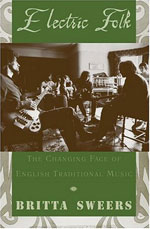
I’m no expert on electric folk, and I’ve no real interest in this area of music beyond what I know. I like the work of Gryphon, who combined medieval music with rock, am partial to the music of Mr. Fox who manage to combine the Velvet Underground’s drones with electric folk, and otherwise have a couple of cheap folk anthologies. The intriguing thing is that this small collection of work already seems to offer up a wider spectrum of folk than Sweers’ book! She pretty much centres on the mainstream work of Steeleye Span and Fairport Convention, both popular and successful groups [and therefore well documented so she can reference the subject] along with a sketchy history of folk in Britain.
There’s some intriguing stuff in passing about the collection and sanitization of songs from around the country, infighting and arguments at Cecil Sharp House, folk rock’s relationship to progressive rock, to politics and also some discussion of the music’s relationship to other similar-but-different music abroad. There’s also some discussion of how the music changes as time goes on, and how a similar process, sometimes allied to hybridity or the combing of several songs, happens with lyrics too.
But in the main I’d have liked to have read more about some of the interesting electrical experiments with folk and, at the other end of the musical spectrum, what happens on a simple level when a singer uses an electric guitar instead of an acoustic. I’d also have liked more about electric folk’s relationship with folk rather than the pop/rock world. And mostly I just wanted to know about more: more music, more bands, more details. This book hardly touches the surface of things, and when it does achieve any depth it often becomes simply boring, a detailed personnel list of one band, for instance.
One band whose work is obscure is Parchment, who recorded two fantastic [and very collectable] LPs Hollywood Sunset and Shamblejam for the Pye record label back in the early 70s. These, I’ve just discovered, were reissued last year, along with two lesser LPs recorded for christian labels, by Kingsway on a cheapo triple CD. It’s good to hear their uptempo stomps and love songs again, along with intriguing covers of tracks by Judee Sill and Gallagher & Lyle. The eclecticism of their albums from hillbilly ragtime through solo voice to pop with a hint of tijuana brass has been added to by somebody’s decision to mix up all the songs rather than present them as the albums did. This isn’t a problem for itunes, but it doesn’t help the casual listener! What I most enjoy about the work is the 70s freakout electric guitar solos, which are held in restraint, down low in the mix, and the bright rhythm guitar and banjo underpinning the band’s spiritual searching. The trios’ harmony’s are good, too. Well worth a listen despite being of course ignored by Ms Sweers!
© 2005 Rupert Loydell